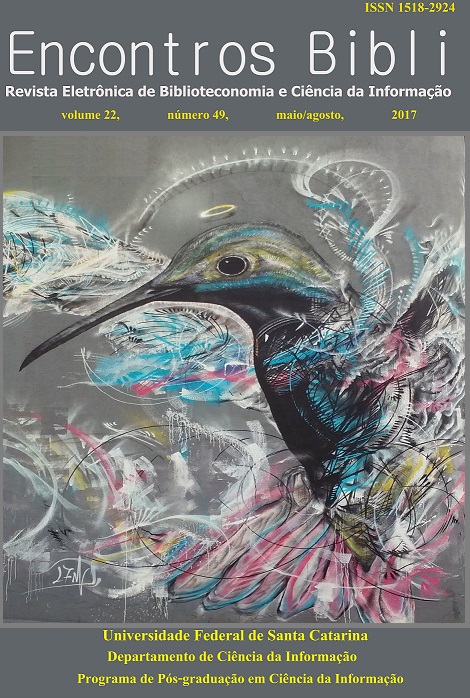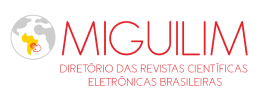Use of design thinking as a tool in the process of innovation in libraries
DOI:
https://doi.org/10.5007/1518-2924.2017v22n49p59Keywords:
Design Thinking, Libraries, Origin of Design Thinking, Phases of Design Thinking, Information ScienceAbstract
http://dx.doi.org/10.5007/1518-2924.2017v22n49p59
This study to present a theoretical article on success stories of Design Thinking (DT) in libraries, which aimed to study the Design Thinking through of the story, the phases that make up this methodology, as well as the importance of the stage of prototyping, and the relevance of Design Thinking in Information Science. To this end, it was made a bibliographical research where databases employed to collect relevant information were the Capes journal articles, authors of books and internet pages. As a result of analysis of the information it was able to identify the importance of DT in the field of Information Science and the advantages that can represent this new methodology to a level academic and business.
Downloads
References
BEHARRY, A. K.; PUN, K. F. Managing Innovation Practices of SMEs in the Caribbean: An Exploratory Study. IEEE Int/l Technology Management Conference Managing Proceeding, 2011.
BIBLORED. Biblored Red Capital de Bibliotecas Públicas. Disponível em: <http://www.biblored.gov.co>. Acesso em: 01 dez. 2015.
BOCCATO, V. R. C. Metodologia da pesquisa bibliográfica na área odontológica e o artigo científico como forma de comunicação. Rev. Odontol. Univ. Cidade São Paulo. São Paulo, v. 18, n. 3, p. 265-274, 2006.
BONINI, Luiz; ENDO, Gustavo. Bilbioteca Terra Forum Consultores. Disponível em: <http://www.terraforum.com.br>. Acesso em: 15 out. 2015.
BROWN, Tim. Design thinking. Harvard Business Review, v. 86, n. 6, p. 85-92, jun. 2008.
BROWN, Tim. Ideo. 2010. Disponível em: <https://www.ideo.com/about/>. Acesso em: 21 nov. 2015.
BROWN, Tim. Uma metodologia poderosa para decretar o fim das velhas ideias design thinking. Rio de Janeiro: Elsevier, 2010, 249 p.
CASTELLS, Manuel. Conferencia de UNRISD, publicado no periódico UNRISD News. Informational Capitalism and Social Exclusión, n. 19, outono – inverno, p. 4-6. (1998).
CASTELLS, Manuel. Informational Capitalism and Social Exclusión, Nº 19, outono – inverno, páginas 4-6, 1998
CRUZ-RIASCOS, Sonia. Inovação em serviços e produtos de informação para a sustentabilidade das bibliotecas das Instituições Federais de Ensino Superior brasileiras: de Gutenberg às redes virtuais. In: Congresso Brasileiro de Biblioteconomia, Documentação e Ciência da Informação, 25, 2013, Florianópolis, Anais... Florianópolis SC, Brasil, 2013, p. 1 – 13.
DUNE, David; MARTIN, Roger. Academy of Management Learning & Education, v. 5, n. 4, p. 512–523. 2006
DROEGE, H. D; HILDEBRAND, et al. Innovation in services: present findings, and future pathways. Journal of Service Management 20(2): 131-155. 2009.
FASCINE, Ligia. O que é o Design Thinking. 2014. Disponível em: <http://www.ideiademarketing.com.br/2012/02/06/o-que-e-design-thinking-entrevista-com-ligia-fascioni/>. Acesso em: 06 abr. 2014
FIGUEIREDO, Nice. Estudos de uso e usuários da informação. Brasília: IBICT, 1994. 154 p.
GIL, Antonio. Métodos e Técnicas de Pesquisa Social. 6 ed. São Paulo: Atlas, 2008.
HASEN, Morten; BIRKINSHAW, Julian. La cadena de valor de la innovación. Harvard Business Review, v. 85, n. 6, p. 106 – 116, jun. 2007.
HASSO – PLATTNER – INSTITUT. School of Design Thinking. Disponível em: <http://hpi.de/en/school-of-design-thinking/design-thinking/mindset.html>. Acesso em: 22 nov. 2015.
HOWELLS, J. Where to from here for services innovation? Paper presented at the Knowledge Intensive Services Activities (KISA) Conference, Sydney, 22 March 2006.
IDEO. Design thinking for libraries: A toolkit for patron-centered design. Disponível em: <http://designthinkingforlibraries.com/>. Acesso em: 30 nov. 2015.
JULIANI, Jordan; CAVAGLIERI, Marcelo; MACHADO, Raquel. Design Thinking como ferramenta para a geração de inovação: um estudo de caso da Biblioteca Universitária da UDESC. InCID: R. Ci, Inf. e Doc. Ribeirão Preto, v. 6, n. 2, p. 66 – 83, set. 2015.
KARLSSON, C.; AHLSTROM, P. Perspective: changing product development strategy-a managerical challenge. Journal of Product Innovation Management.n.14,v.6 p.473-484.
LOVELOOK,C.H. Developing and implementing new services. In: George, W.R and Marshal, C. E. (eds) Developing New Services, American Marketing Association, Chicago: IL p.44-64.
MCGREW, Anthony; LEWIS, Paul. Globalisation and the Nation States, Cambridge, Inglaterra, Polity Press, 1992. 352 p.
MCKIM, Robert. A. Experiences in visual thinking. Brooks/Cole Publishing Company, 1980.183 p.
NITZSCHE, Rique. Afinal o que é design thinking?. São Paulo: Rosari, 2012, 208 p.
NOSMUT(DOT)COM. Design thinking. Disponível em: <http://web109.srv4.sysproserver.de/Design_thinking.html>. Acesso em: 28 nov. 2015.
OCDE. Manual de Oslo: Guía para la recogida e interpretación de datos sobre innovación. 3. ed. España: Grupo Traga. 2005. 194 p.
OSTROM, A.; BITNER, M. et al. Moving forward and making a difference: research priorities for the science of service. Journal of Service Research, v.13, n.1 p. 4, 2010.
PONTI, Franc. Avianca em revista. Bogotá, v. 2, n. 30, p. 176, nov. 2015.
PROGRAMA DE CIDADES SUSTENTÁVEIS. Bibliotecas em Bogotá. Disponível em: <http://www.cidadessustentaveis.org.br/boas-praticas/bibliotecas-em-bogota>. Acesso em: 01 dez. 2015.
ROWE, Peter G. Design Thinking. Cambridge, Massachuttes: The MIT Press. 1987. 229 p.
SCOZZI, GARAVELLI, C., CROWSTON, K., “Methods for modeling and supporting innovation processes in SMEs”, European Journal of Innovation Management, vol. 8, no. 1, pp. 120–137, 2005.
SIMON, Herbert A. The Sciences of the Artificial. MIT Press, Cambridge, Mass, 1969.
SPOHRER, J.; Maglio, P.P. Toward a science of service systems: Value and symbols. In: Maglio, P.P.; C. A. Kieliszewski and J. C. Spohrer (Eds.). Handbook of service science. New York: Springer. 2010.
STEINBECK, Reinhold. Revista científica de educomunicación, v. XIX, n. 37, p. 27-35. Out. 2011.
VASCONCELLOS, Luís; MARX, Roberto. Como ocorrem as inovações em serviços? Um estudo exploratório de empresas no Brasil. Gest. Prod., São Carlos, v. 18, n. 3, p. 443-460, 2011.
VERGARA, Sylvia. Projetos e relatórios de pesquisa em Administração. 6. ed. São Paulo: Atlas, 2005.
BEHARRY, A. K.; PUN, K. F. Managing Innovation Practices of SMEs in the Caribbean: An Exploratory Study. IEEE Int/l Technology Management Conference Managing Proceeding, 2011.
BIBLORED. Biblored Red Capital de Bibliotecas Públicas. Disponível em: <http://www.biblored.gov.co>. Acesso em: 01 dez. 2015.
BOCCATO, V. R. C. Metodologia da pesquisa bibliográfica na área odontológica e o artigo científico como forma de comunicação. Rev. Odontol. Univ. Cidade São Paulo. São Paulo, v. 18, n. 3, p. 265-274, 2006.
BONINI, Luiz; ENDO, Gustavo. Bilbioteca Terra Forum Consultores. Disponível em: <http://www.terraforum.com.br>. Acesso em: 15 out. 2015.
BROWN, Tim. Design thinking. Harvard Business Review, v. 86, n. 6, p. 85-92, jun. 2008.
BROWN, Tim. Ideo. 2010. Disponível em: <https://www.ideo.com/about/>. Acesso em: 21 nov. 2015.
BROWN, Tim. Uma metodologia poderosa para decretar o fim das velhas ideias design thinking. Rio de Janeiro: Elsevier, 2010, 249 p.
CASTELLS, Manuel. Conferencia de UNRISD, publicado no periódico UNRISD News. Informational Capitalism and Social Exclusión, n. 19, outono – inverno, p. 4-6. (1998).
CASTELLS, Manuel. Informational Capitalism and Social Exclusión, Nº 19, outono – inverno, páginas 4-6, 1998
CRUZ-RIASCOS, Sonia. Inovação em serviços e produtos de informação para a sustentabilidade das bibliotecas das Instituições Federais de Ensino Superior brasileiras: de Gutenberg às redes virtuais. In: Congresso Brasileiro de Biblioteconomia, Documentação e Ciência da Informação, 25, 2013, Florianópolis, Anais... Florianópolis SC, Brasil, 2013, p. 1 – 13.
DUNE, David; MARTIN, Roger. Academy of Management Learning & Education, v. 5, n. 4, p. 512–523. 2006
DROEGE, H. D; HILDEBRAND, et al. Innovation in services: present findings, and future pathways. Journal of Service Management 20(2): 131-155. 2009.
FASCINE, Ligia. O que é o Design Thinking. 2014. Disponível em: <http://www.ideiademarketing.com.br/2012/02/06/o-que-e-design-thinking-entrevista-com-ligia-fascioni/>. Acesso em: 06 abr. 2014
FIGUEIREDO, Nice. Estudos de uso e usuários da informação. Brasília: IBICT, 1994. 154 p.
GIL, Antonio. Métodos e Técnicas de Pesquisa Social. 6 ed. São Paulo: Atlas, 2008.
HASEN, Morten; BIRKINSHAW, Julian. La cadena de valor de la innovación. Harvard Business Review, v. 85, n. 6, p. 106 – 116, jun. 2007.
HASSO – PLATTNER – INSTITUT. School of Design Thinking. Disponível em: <http://hpi.de/en/school-of-design-thinking/design-thinking/mindset.html>. Acesso em: 22 nov. 2015.
HOWELLS, J. Where to from here for services innovation? Paper presented at the Knowledge Intensive Services Activities (KISA) Conference, Sydney, 22 March 2006.
IDEO. Design thinking for libraries: A toolkit for patron-centered design. Disponível em: <http://designthinkingforlibraries.com/>. Acesso em: 30 nov. 2015.
JULIANI, Jordan; CAVAGLIERI, Marcelo; MACHADO, Raquel. Design Thinking como ferramenta para a geração de inovação: um estudo de caso da Biblioteca Universitária da UDESC. InCID: R. Ci, Inf. e Doc. Ribeirão Preto, v. 6, n. 2, p. 66 – 83, set. 2015.
KARLSSON, C.; AHLSTROM, P. Perspective: changing product development strategy-a managerical challenge. Journal of Product Innovation Management.n.14,v.6 p.473-484.
LOVELOOK,C.H. Developing and implementing new services. In: George, W.R and Marshal, C. E. (eds) Developing New Services, American Marketing Association, Chicago: IL p.44-64.
MCGREW, Anthony; LEWIS, Paul. Globalisation and the Nation States, Cambridge, Inglaterra, Polity Press, 1992. 352 p.
MCKIM, Robert. A. Experiences in visual thinking. Brooks/Cole Publishing Company, 1980.183 p.
NITZSCHE, Rique. Afinal o que é design thinking?. São Paulo: Rosari, 2012, 208 p.
NOSMUT(DOT)COM. Design thinking. Disponível em: <http://web109.srv4.sysproserver.de/Design_thinking.html>. Acesso em: 28 nov. 2015.
OCDE. Manual de Oslo: Guía para la recogida e interpretación de datos sobre innovación. 3. ed. España: Grupo Traga. 2005. 194 p.
OSTROM, A.; BITNER, M. et al. Moving forward and making a difference: research priorities for the science of service. Journal of Service Research, v.13, n.1 p. 4, 2010.
PONTI, Franc. Avianca em revista. Bogotá, v. 2, n. 30, p. 176, nov. 2015.
PROGRAMA DE CIDADES SUSTENTÁVEIS. Bibliotecas em Bogotá. Disponível em: <http://www.cidadessustentaveis.org.br/boas-praticas/bibliotecas-em-bogota>. Acesso em: 01 dez. 2015.
ROWE, Peter G. Design Thinking. Cambridge, Massachuttes: The MIT Press. 1987. 229 p.
SCOZZI, GARAVELLI, C., CROWSTON, K., “Methods for modeling and supporting innovation processes in SMEs”, European Journal of Innovation Management, vol. 8, no. 1, pp. 120–137, 2005.
SIMON, Herbert A. The Sciences of the Artificial. MIT Press, Cambridge, Mass, 1969.
SPOHRER, J.; Maglio, P.P. Toward a science of service systems: Value and symbols. In: Maglio, P.P.; C. A. Kieliszewski and J. C. Spohrer (Eds.). Handbook of service science. New York: Springer. 2010.
STEINBECK, Reinhold. Revista científica de educomunicación, v. XIX, n. 37, p. 27-35. Out. 2011.
VASCONCELLOS, Luís; MARX, Roberto. Como ocorrem as inovações em serviços? Um estudo exploratório de empresas no Brasil. Gest. Prod., São Carlos, v. 18, n. 3, p. 443-460, 2011.
VERGARA, Sylvia. Projetos e relatórios de pesquisa em Administração. 6. ed. São Paulo: Atlas, 2005.
Published
How to Cite
Issue
Section
License
Copyright (c) 2017 Diana Marcela Bernal Ramírez, Thais Zaninelli

This work is licensed under a Creative Commons Attribution 4.0 International License.
The author must guarantee that:
- there is full consensus among all the coauthors in approving the final version of the document and its submission for publication.
- the work is original, and when the work and/or words from other people were used, they were properly acknowledged.
Plagiarism in all of its forms constitutes an unethical publication behavior and is unacceptable. Encontros Bibli has the right to use software or any other method of plagiarism detection.
All manuscripts submitted to Encontros Bibli go through plagiarism and self-plagiarism identification. Plagiarism identified during the evaluation process will result in the filing of the submission. In case plagiarism is identified in a manuscript published in the journal, the Editor-in-Chief will conduct a preliminary investigation and, if necessary, will make a retraction.
This journal, following the recommendations of the Open Source movement, provides full open access to its content. By doing this, the authors keep all of their rights allowing Encontros Bibli to publish and make its articles available to the whole community.
Encontros Bibli content is licensed under a Creative Commons Attribution 4.0 International License.
Any user has the right to:
- Share - copy, download, print or redistribute the material in any medium or format.
- Adapt - remix, transform and build upon the material for any purpose, even commercially.
According to the following terms:
- Attribution - You must give appropriate credit, provide a link to the license, and indicate if changes were made. You may do so in any reasonable manner, but not in any way that suggests the licensor endorses you or your use.
- No additional restrictions - You may not apply legal terms or technological measures that legally restrict others from doing anything that the license permits.

























